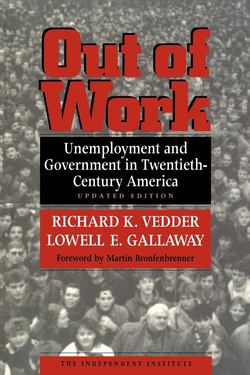Out of Work

Реклама. ООО «ЛитРес», ИНН: 7719571260.
Оглавление
Richard K Vedder. Out of Work
About NYU Press
Out of Work
Contents
Foreword
NOTES
Preface to the Updated Edition
Preface to the First Edition
1. The Unemployment Century
Variations in Unemployment over Time
Spatial Variations in Unemployment
Demographic Variations in Unemployment
RACIAL DIFFERENCES
GENDER DIFFERENCES
TEENAGE UNEMPLOYMENT
The Importance of Unemployment
NOTES
2. Unemployment in Theory
Wage-Based Perspectives on Unemployment
AUSTRIAN PERSPECTIVES ON UNEMPLOYMENT
A Digression on Unemployment Statistics
Underconsumptionist and Income-Expenditure Approaches
Late Twentieth-Century Perspectives on Unemployment
MONETARISM
EXPECTATIONS AND THE NEW CLASSICAL ECONOMICS
NOTES
3. The Neoclassical/Austrian Approach: An Overview
Testing the Basic Model
The Changing Flexibility of Wages, Prices, and Productivity
Criticisms of the Model
DATA PROBLEMS
EXPANDED LAG STRUCTURE
ISSUES OF CAUSALITY
NOTES
4. The Gilded Age
The Unemployment Experience, 1900–1929
Interpreting the Unemployment Experience, 1900–1919
The 1920–1922 Depression. THE EMPIRICAL EVIDENCE
EVIDENCE FROM THE IRON AND STEEL INDUSTRY
CONTEMPORARY ANALYSIS OF THE 1921 DEPRESSION
The New Era, 1922–1929
THE EMPIRICAL RECORD AND THE WAGES HYPOTHESIS
THE GENESIS OF THE IMPENDING CRISIS
NOTES
5. From New Era to New Deal
Economic Decline: 1929–1933
Monthly Estimates of Unemployment Rates
Unemployment and the Adjusted Real Wage, 1929–1933
Alternative Statistical Estimation with Quarterly Data
Unemployment and the “New Economics” of Herbert Hoover
IMPLEMENTING THE HIGH-WAGE POLICY
Evaluating the Success of the High-Wage Policy Empirically
The Unemployment Effects of Smoot-Hawley
The Economics Profession and the High-Wage Policy. CONTEMPORARY REACTIONS
THE IDEAS OF LATER ECONOMISTS
Unemployment and Wages: The European Experience
NOTES
6. The Banking Crisis and the Labor Market
Financial Dimensions of the High-Wage Policy
The Impact on Banks
An Econometric Test of the Wage-Banking Relationship
The High-Wage Policy and Financial Markets
The Depression Scenario: A Summary
NOTES
7. The New Deal
The Unemployment Experience, 1933–1941
Trends in Wages, Prices, and Productivity
Factory Employment Trends
A Tale of Two Industries: Steel and Autos
The Impact of the New Deal on Unemployment
Other Perspectives on New Deal Unemployment
THE 1937–1938 DOWNTURN
NOTES
8. The Impossible Dream Come True
Wartime-Era Unemployment and the Adjusted Real Wage
Statistical Problems in the Command Economy of the Wartime Era
THE EVOLUTION OF WAGE AND PRICE CONTROLS
THE DISTORTIONAL EFFECT OF PRICE CONTROLS
The Postwar Recovery
STATISTICAL PROBLEMS
WHY THE ERROR IN THE GOVERNMENT’S REVISED STATISTICS?
ECONOMIC INTERPRETATIONS OF THE POSTWAR RECONVERSION
THE REVISED KEYNESIAN INTERPRETATION OF RECONVERSION
ASSESSING THE KEYNESIAN INTERPRETATION
The Postwar Reconversion and the Adjusted Real Wage Model
NOTES
9. The Gentle Time
The National Income Account Data
Attitudes Toward Economic Policy
THE INTELLECTUAL VIEW
The Real World: What Happened?
The First Test: The 1949 Recession
The 1953–1954 Recession
The 1958 Recession
What About Monetary Policy?
NOTES
10. The Camelot Years
NOTES
11 “Pride Goeth Before a Fall”
The 1970s in Detail
How Well Did Demand Management Work?
The State of Economic Thinking at the End of the Decade
NOTES
12. The Winds of Change
The Experience of the Eighties
THE GREAT DISINFLATION
THE RECESSION OF 1982
THE SKY IS FALLING!
DOES KEYNES LIVE?
STABILITY IN THE EIGHTIES
NOTES
13. The Natural Rate of Unemployment
An Overview of the Natural Rate of Unemployment
TRENDS IN CYCLICAL UNEMPLOYMENT BRIEFLY REVISITED
TRENDS IN THE NATURAL RATE OF UNEMPLOYMENT
Frictional Unemployment in Recent Decades
The Increase in Structural Unemployment
AGE COMPOSITION OF THE LABOR FORCE
GROWTH IN LABOR SUPPLY
CHANGING COMPOSITION OF JOBS
Governmental Policies and Structural Unemployment
FIVE WAGE-ENHANCING POLICIES OF GOVERNMENT
GOVERNMENTAL POLICIES RAISING THE RESERVATION WAGE
OTHER PUBLIC POLICIES
Spatial Dimensions of American Unemployment
NOTES
14. Who Bears the Burden of Unemployment?
White-Nonwhite Unemployment Differentials over One Hundred Years
THE 1890 AND 1900 CENSUSES
THE 1930 CENSUS
THE UNEMPLOYMENT-RATE DIFFERENTIAL SINCE 1940
Searching for an Explanation for Widening Differentials
I. RACIAL DISCRIMINATION
2. CHANGING JOB AND LOCATIONAL CHOICES OF NONWHITES
J. DIFFERENTIAL RACIAL IMPACT OF GOVERNMENTAL POLICIES
Further Evidence: Changing Employment-Population Ratios
Gender Differences in Unemployment
Teenage Unemployment Differentials
NOTES
15. Unemployment and the State
The State and the Business Cycle
In the Long Run Many of Us Are Alive
The Contemporary Scene
NOTES
16. Afterword
Unemployment and Public Policy
The Best of Times, the Worst of Times
THE ECONOMY DURING THE PRE-SUPPLY-SIDE ERA
THE ECONOMY DURING THE SUPPLY-SIDE ERA
POST-SUPPLY-SIDE ECONOMIC PERFORMANCE
LONGER-RUN CONSEQUENCES
THE GREAT SLOWDOWN
The New Stagnation
The New Stagnationism in Perspective
NOTES
Appendix A. The Extended Theoretical Model
NOTES
Appendix B. The Technical Aspects of the Statistical Analysis
The Issue of Replicability
The Causality Question
Model Specification Issues
Some Additional Tests
Summary of Equation Evaluation Tests
A Comparison of Predicted and Actual Levels of Unemployment
The World since 1989
Rational Expectations and Slutsky Cycles
RATEX versus Slutsky Outcomes
PARTIAL DECAY PARAMETERS
DECAY PARAMETERS AS AN ADJUSTMENT MECHANISM
CONCLUSIONS
Adjusted Real Wages and Economic Growth
Spatial Variations in Unemployment Revisited
RACE AND UNEMPLOYMENT
THE PERSISTENCE OF UNEMPLOYMENT
CONCLUSIONS
Concluding Remarks
NOTES
Bibliography. Books
Articles
Government Documents
Index
ABOUT THE AUTHORS
Отрывок из книги
Thank you for buying this ebook, published by NYU Press.
Sign up for our e-newsletters to receive information about forthcoming books, special discounts, and more!
.....
2. On the behavior of economists of the late neoclassical era, see William J. Barber, From New Era to New Deal (Cambridge: Cambridge University Press, 1985).
3. This is so in part because of the famous law of diminishing returns. Also, where there is imperfect competition in product markets, firms must lower prices to sell increased output, lowering the dollar revenue received per unit of increased production. Profit maximizing firms will hire workers up to the point where the marginal cost of the labor is equal to the marginal revenue product of the labor.
.....